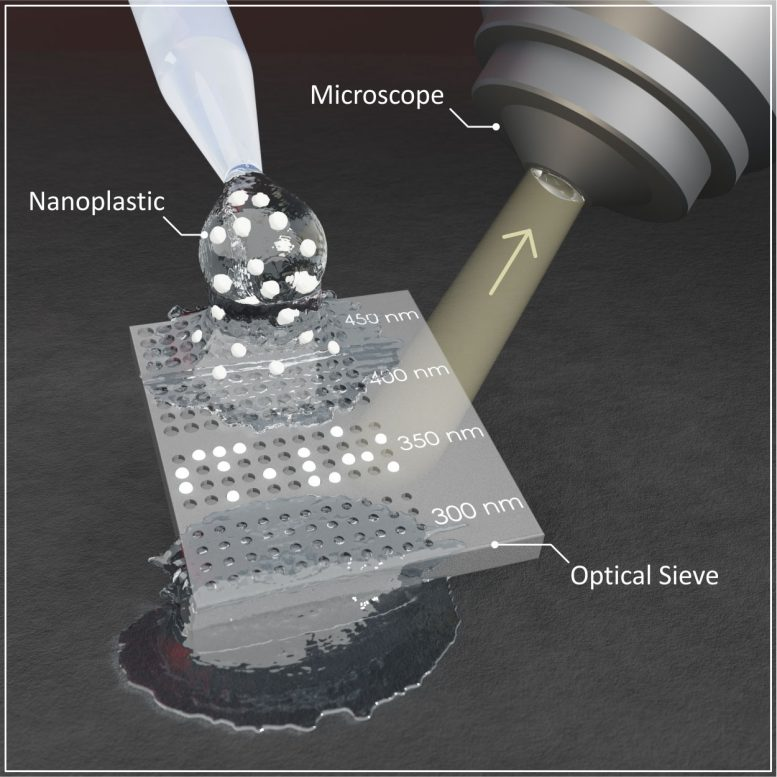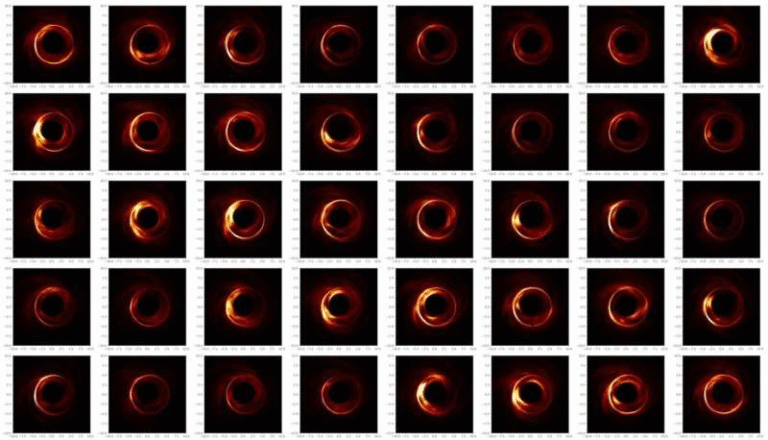A New Test Strip That Makes Nanoplastics Visible

Researchers from the University of Stuttgart in Germany, working with the University of Melbourne in Australia, have introduced a new way to detect nanoplastics — the tiniest plastic fragments that pose serious environmental and health risks.
Their invention, called the optical sieve, acts like a simple test strip and makes these otherwise invisible particles visible under a standard optical microscope. The study, published in Nature Photonics, outlines how this method can detect, size, and count nanoplastics quickly and affordably.
Why Nanoplastics Are a Problem
Plastic pollution is already recognized as one of the major global challenges of the 21st century. Large plastic waste is visible on beaches, rivers, and oceans, while microplastics — particles smaller than 5 mm — have been found in the bodies of animals and even humans.
But the issue runs deeper. Nanoplastics are even smaller than microplastics, often less than one micrometer in diameter (a human hair is about 70 micrometers wide for comparison). These particles result from the breakdown of larger plastics and are especially worrying because:
- They are too small to see with the naked eye.
- They can penetrate biological barriers, including skin and the blood-brain barrier.
- They may accumulate in tissues, potentially affecting long-term health.
Until now, studying nanoplastics has been extremely difficult because no rapid, affordable, and accessible method existed to detect them.
The Optical Sieve: How It Works
The optical sieve is a small chip with microscopic holes (called Mie voids) etched into a semiconductor material. These holes have very specific diameters and depths. When light shines on them, they reflect distinct colors depending on their size and shape.
Here’s the clever part:
- When a nanoplastic particle of the right size falls into one of these holes, the color of that hole changes.
- By simply looking at the test strip under a standard optical microscope, researchers can see these color shifts and know whether nanoplastics are present.
- Because the sieve contains holes of different sizes, it can also reveal the size distribution of the particles in the sample.
This method effectively turns the chip into both a filter and a sensor at the same time.
Specific Details From the Study
The study provides very concrete numbers and methods.
- The system works for nanoplastics ranging from 0.2 micrometers (200 nanometers) up to 1 micrometer in size.
- Researchers tested the sieve using spherical plastic particles of various diameters — 350 nm, 550 nm, and 1 µm.
- Because there aren’t reliable natural samples with known nanoplastic concentrations, they created their own test environment. They used lake water, added sand and organic material, and then spiked it with a known concentration of plastic particles.
- The concentration used in testing was 150 micrograms per milliliter.
- After filtering the water sample with the optical sieve, the particles filled the voids. The microscope revealed clear color changes, which confirmed both particle size and particle count.
This experiment proved that the optical sieve can handle complex, real-world water samples and still deliver accurate results.
Advantages Over Traditional Methods
Traditionally, nanoplastics have been studied using tools such as scanning electron microscopy (SEM). While SEM can provide detailed images, it is:
- Very expensive.
- Slow, requiring extensive preparation.
- Operated only by specially trained personnel.
In comparison, the optical sieve is:
- Much cheaper, requiring only a standard optical microscope.
- Faster, delivering results without heavy sample preparation.
- User-friendly, opening the possibility for broader use in labs without specialized staff.
This makes it one of the most accessible methods yet for studying nanoplastics.
Potential Uses
The optical sieve isn’t just for lab research. It could eventually be used as a portable test strip in the field. Researchers imagine scenarios like:
- Testing water or soil samples on-site without needing to ship them back to a lab.
- Screening biological samples such as blood or tissue for nanoplastic contamination.
- Expanding environmental monitoring programs by providing affordable, easy-to-use tools.
The team also plans to:
- Test the method with non-spherical nanoplastic particles, which are more representative of what is found in the environment.
- Develop ways to distinguish between different types of plastic polymers, not just detect their presence.
- Partner with other research groups experienced in real environmental sampling to further validate the technique.
How the Color Effect Works
The science behind the color change is worth noting. The holes in the sieve, or Mie voids, act as tiny resonators. When light hits them, they resonate at specific wavelengths depending on their geometry.
- An empty void reflects a particular color.
- If a particle enters the void, it shifts the resonance and the reflected color changes.
- This color shift is visible even with a simple RGB camera attached to a microscope.
In short, it transforms something invisible into something directly observable.
Challenges and Current Limitations
While promising, the optical sieve is still in its early stages.
- The tests so far mainly involved spiked water samples, not natural water samples containing unknown concentrations of diverse nanoplastics.
- Real-world nanoplastics are often irregular, jagged, or clumped, not neat spherical beads. These irregular shapes may behave differently in the sieve.
- The current version can detect the size and number of particles but does not yet reveal the chemical composition of the plastic. This means it cannot distinguish between, say, polyethylene and polystyrene.
- The lower detection limit is currently about 200 nanometers. Detecting smaller particles, such as those closer to 100 nanometers or less, will be a bigger challenge.
- Fabrication of the test strip requires precision engineering. Small errors in the depth or width of the voids could affect performance.
These are hurdles the researchers acknowledge and plan to tackle in future work.
Why This Matters for Human Health
One of the reasons this technology is so exciting is its potential application in health research. Studies have already detected microplastics in human blood, lungs, and even placental tissue. The concern is that nanoplastics, being even smaller, might be able to:
- Cross the blood-brain barrier.
- Interact with cells and proteins in unexpected ways.
- Accumulate in organs over time.
Without a reliable detection method, it has been nearly impossible to measure these risks properly. The optical sieve could open the door to systematic studies of nanoplastic exposure in humans.
Broader Context: Plastics and the Environment
To understand the importance of this breakthrough, it helps to look at the bigger picture of plastics in the environment.
- The world produces more than 400 million tons of plastic every year.
- A significant fraction ends up as waste in oceans, rivers, and soils.
- Over time, these plastics break down into smaller fragments, eventually becoming microplastics and nanoplastics.
- Microplastics have been found in fish, shellfish, table salt, and even drinking water.
- Research suggests that nanoplastics could pose even more serious risks because they interact at the cellular and molecular levels.
This makes the development of new detection tools not just useful, but essential.
The Future of Nanoplastic Research
The optical sieve is likely just the beginning. Once validated and optimized, such tools could transform the way scientists monitor plastic pollution. Future directions might include:
- Creating handheld devices for environmental inspectors.
- Integrating the technology into water treatment plants to track and potentially reduce nanoplastic content.
- Expanding its design to target smaller particles below 200 nm.
- Combining it with chemical analysis techniques so that particle type as well as size can be identified in one step.
In many ways, this invention is a turning point. It shifts the study of nanoplastics from something restricted to a few highly specialized labs to something that could soon be done almost anywhere.
Conclusion
The invention of the optical sieve marks a significant step forward in detecting nanoplastics. It’s fast, affordable, and accessible, offering a fresh alternative to expensive electron microscopes. While it still has limitations, its potential applications in environmental monitoring and health research are wide-reaching.
As nanoplastic pollution becomes an increasingly urgent concern, this new method provides scientists with a much-needed tool to uncover and understand the invisible threats surrounding us.
Reference: Optical sieve for nanoplastic detection, sizing and counting – Nature Photonics (2025)





